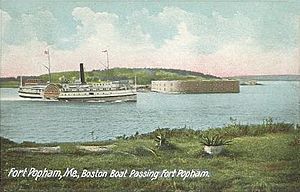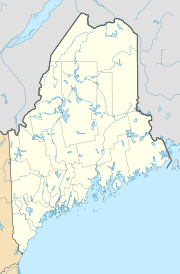Phippsburg, Maine facts for kids
Quick facts for kids
Phippsburg, Maine
|
|
|---|---|

|
|
| Nickname(s):
The Burg
|
|
| Country | United States |
| State | Maine |
| County | Sagadahoc |
| Incorporated | 1814 |
| Area | |
| • Total | 71.20 sq mi (184.41 km2) |
| • Land | 28.58 sq mi (74.02 km2) |
| • Water | 42.62 sq mi (110.39 km2) |
| Elevation | 128 ft (39 m) |
| Population
(2020)
|
|
| • Total | 2,155 |
| • Density | 75/sq mi (29.1/km2) |
| Time zone | UTC−5 (Eastern (EST)) |
| • Summer (DST) | UTC−4 (EDT) |
| ZIP Codes |
04562, 04565, 04567
|
| Area code(s) | 207 |
| FIPS code | 23-58515 |
| GNIS feature ID | 0582675 |
Phippsburg is a town in Sagadahoc County, Maine, United States. It sits on the west side of the mouth of the Kennebec River. In 2020, about 2,155 people lived there.
Phippsburg is a popular place for tourists. It has several interesting spots. These include the Bates-Morse Mountain Conservation Area and Fort Popham State Historic Site. You can also find Fort Baldwin there, which looks over Fort Popham. Popham Beach State Park and Pond Island National Wildlife Refuge are also in Phippsburg. Part of Winnegance is also within the town's borders.
Contents
History of Phippsburg
Early English Settlements
Phippsburg was the site of the Popham Colony. This was the first known English attempt to settle in New England. It happened between 1607 and 1608. During this short time, the colonists built a ship called Virginia of Sagadahoc. This was the first ship built in Maine's long history of shipbuilding.
Another British settlement started near the mouth of the Kennebec River in 1653. A fisherman named Thomas Atkins bought the southern part of Phippsburg. He bought it from a Native American leader named Mowhotiwormet, also known as Chief Robinhood. Atkins Bay is named after him.
Conflicts and Abandonment
More people moved to the area over time. But during King Philip's War in August 1676, Native Americans attacked. They killed or captured the colonists on the east side of the Kennebec River. Homes were burned, and farm animals were killed. The entire area was left empty.
Settlers returned in 1679 to a place called Newtown. This was on the southern end of Arrowsic Island, across the river from today's Phippsburg Center. Around 1684, Francis Small had a trading post at Cape Small, which is named after him. But in 1689, the area was destroyed and deserted again during King William's War.
Peace and Resettlement
Peace finally came with the Treaty of Portsmouth in 1713. This treaty ended the fighting between the Abenaki Indians and English settlements. In 1714, Newtown was rebuilt. In 1716, it became Georgetown-on-Arrowsic.
Also in 1716, a group called the Pejepscot Proprietors started a small fishing village. It was called Augusta, located in the Small Point Harbor area of Phippsburg. Dr. Oliver Noyes, who led the colony, built a stone fort to protect it. In 1717, Governor Samuel Shute met with tribal leaders at Georgetown-on-Arrowsic. The leaders arrived in many canoes and camped on Lee Island.
More Conflicts and Growth
In the summer of 1723, during Dummer's War, the Norridgewocks and their allies attacked the area. They were encouraged by a French missionary named Sebastien Rale. The area was deserted again, and the stone fort was destroyed.
Governor William Dummer's Treaty of 1725 brought peace back. In 1737, people tried to resettle Cape Small Point. The boundaries of Georgetown-on-Arrowsic grew to include most of present-day Phippsburg. It also included Bath, Woolwich, and Georgetown.
By 1751, ten farms were along the Kennebec River in Phippsburg. Five more were on the Casco Bay side. But the different districts started to separate. Woolwich left in 1759, and Bath followed in 1781.
Becoming Phippsburg
In 1814, Phippsburg officially became its own town. The original request was to name it Dromore. This was after one of the oldest parts of the town. But Massachusetts chose to honor Sir William Phips, a royal governor from Woolwich.
Between 1842 and 1890, many wooden ships were built in Phippsburg. The town also had several mills that used the power of the tides.
Forts and Tourism
Fort Popham was built during the American Civil War to protect the mouth of the Kennebec River. It was built on the site of an older fort from 1808. In the 1890s, it became a control center for underwater mines. The more modern Fort Baldwin was built between 1905 and 1912. Soldiers were stationed there during both World Wars.
During the Gilded Age, Popham Beach became a popular resort. Steamboats brought visitors from Bath. Today, Phippsburg's main jobs are fishing and tourism.
Spirit Pond Runestones
In 1971, the Spirit Pond runestones were found in Phippsburg. Some people thought these stones showed that Europeans explored North America before Columbus. However, most experts believe they are a hoax. Walter J. Elliot, Jr., a carpenter from Bath, Maine, found the three stones. They are now at the Maine State Museum in Augusta, Maine.
Geography of Phippsburg
Phippsburg covers about 71.20 square miles (184.41 square kilometers). About 28.58 square miles (74.02 square kilometers) is land, and 42.62 square miles (110.39 square kilometers) is water.
The town is on a peninsula. This land sticks out into the water, separating the Kennebec River from Casco Bay. Casco Bay is part of the Atlantic Ocean. Phippsburg is connected to Bath by a bridge and causeway over Winnegance Creek. It also shares a border with West Bath.
State routes 209 and 216 pass through Phippsburg. The town is near Harpswell to the west, West Bath to the northwest, Bath to the north, Arrowsic to the northeast, and Georgetown to the east.
Population Information
The population of Phippsburg has changed over the years. Here's how it has grown and shrunk:
| Historical population | |||
|---|---|---|---|
| Census | Pop. | %± | |
| 1820 | 1,119 | — | |
| 1830 | 1,311 | 17.2% | |
| 1840 | 1,657 | 26.4% | |
| 1850 | 1,805 | 8.9% | |
| 1860 | 1,770 | −1.9% | |
| 1870 | 1,344 | −24.1% | |
| 1880 | 1,497 | 11.4% | |
| 1890 | 1,396 | −6.7% | |
| 1900 | 1,254 | −10.2% | |
| 1910 | 1,079 | −14.0% | |
| 1920 | 872 | −19.2% | |
| 1930 | 801 | −8.1% | |
| 1940 | 1,020 | 27.3% | |
| 1950 | 1,134 | 11.2% | |
| 1960 | 1,121 | −1.1% | |
| 1970 | 1,229 | 9.6% | |
| 1980 | 1,527 | 24.2% | |
| 1990 | 1,815 | 18.9% | |
| 2000 | 2,106 | 16.0% | |
| 2010 | 2,216 | 5.2% | |
| 2020 | 2,155 | −2.8% | |
| U.S. Decennial Census | |||
2010 Census Details
In 2010, there were 2,216 people living in Phippsburg. There were 963 households, which are groups of people living together. Most people in the town were White (97.5%).
The average age in Phippsburg was about 49.8 years old. About 16.5% of the people were under 18 years old. About 21.5% of the people were 65 years old or older. The town had a nearly even number of males and females.
Places to Visit
- Fort Baldwin
- Fort Popham
- Hermit Island
- Malaga Island
See also
 In Spanish: Phippsburg (Maine) para niños
In Spanish: Phippsburg (Maine) para niños


